
Human skin performs many vital functions - from protective to respiratory. By its condition one can judge the health of the whole organism. We are especially attentive to children's delicate skin. It happens that parents notice roughness or even spots in the area of the baby’s legs. What does this mean, is it dangerous? Does a child’s dry skin require treatment and what should be done about it.
Causes of dry skin on a child's feet
Children's skin differs from adults in its receptivity and sensitivity. Its protective properties are still just being formed. It requires additional attention and care. Most often, dry skin is found on a child's legs.
Normally, in the autumn-winter period, children may experience increased dryness of the epidermis. The condition of the skin is affected by factors such as cold, wind, dry hot air in heated rooms. This problem can be dealt with by using various protective creams and installing a household humidifier in a kindergarten or room.
The skin of the legs suffers the most in the summer, when it is hot and the body quickly loses moisture. In this case, cracks may even appear on the feet, into which dust and sand get trapped. This must be taken seriously, because infection can enter the body through wounds.
What factors can cause increased dryness of the skin?
There are quite a lot of them:
- Unbalanced diet. This usually happens if a child refuses normal food. Parents follow the lead and agree that the child eats “at least something.” The children's menu should be varied; it must include fresh fruits, vegetables, meat, and fish. A lack of vitamins A, E and PP inevitably leads to dehydration.
- Poor circulation. This condition may be the result of wearing clothes that are too tight. The same thing happens if a child wears the wrong shoes - smaller than the required size or improperly cut.
- Lack of care. Skin that is overdried due to external factors does not receive proper care. The keratinized areas must be removed with a pumice stone or a washcloth. This will allow air access and prevent the formation of cracks.
- Allergy. Often children are allergic even to gentle baby detergents. This is expressed by dryness, flaking and itching. In this case, you will have to change the soap or gel.
- Parasites. According to some doctors, dry skin on a child’s legs may be a result of parasite infection. For prevention, it is better to undergo smears periodically.
- Hormonal changes. The skin may become dry after using hormonal medications. This also happens during periods of age-related changes. For example, during puberty.
- Frequent bathing. Too frequent bathing (several times a day) with detergents, even mild ones, has a negative effect.
There are many reasons that cause dry epidermis in children. In most cases, nothing bad happens. However, if such a problem occurs suddenly, and usual care does not help, it is better to show the child to a dermatologist.
We look at the video in more detail about the causes of dry skin:
In what cases should you consult a doctor?
Sometimes dry skin on a child’s legs is not a common occurrence, but a symptom of a serious illness. Therefore, you need to carefully consider the situation and monitor the slightest changes.
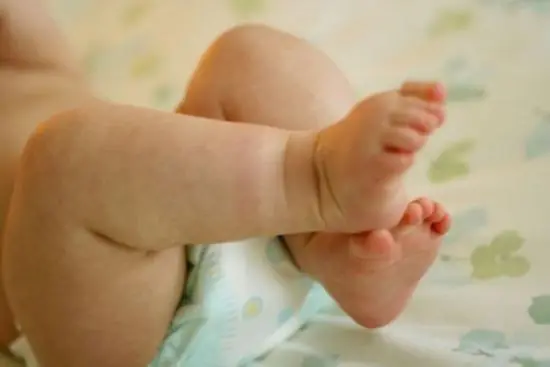
Parents are often concerned about dry patches on their child's skin. They can be physiological in nature, because the fat glands in children still work poorly. Such situations can be resolved with the help of moisturizers or Panthenol.
If the spots do not go away for a long time and do not respond to cosmetic care, you should seek medical advice. Perhaps these are the first signs of pathologies such as atopic dermatitis or psoriasis.
Dry skin is a symptom of the following diseases:
- Eczema. In addition to dryness, children complain of itching and burning sensations. A rash may appear. The disease is not infectious, but allergic in nature.
- Psoriasis. With this disease, dry areas become inflamed, peel, and swelling may appear.
- Atopic dermatitis. Dry skin becomes dense, thickens, and becomes crusty. The disease is of an allergic nature, often caused by heredity.
- Ichthyosis. The skin is covered with dry scales, similar to the skin of fish. Sometimes bubbles form instead. Lesions can affect both individual areas and the entire body.
- Hypothyroidism. Associated symptoms include brittle nails, dull hair, fatigue, and swelling. Occurs due to decreased thyroid function.
- Diabetes. The skin in the folds is most often affected. A serious illness that requires constant monitoring and correction.
- Kidney pathologies. The skin becomes dry and yellowish. The disease is accompanied by decreased appetite, slowness, nausea and even vomiting.
- Keratosis. Rough skin on knees and elbows. The back and abdomen may be affected. It is hereditary and begins to appear in childhood.
- Sjögren's disease. Dry skin is accompanied by problems with vision, teeth and gums.
- Contact dermatitis. Expressed in the appearance of dry spots. An allergic reaction to the material with which the skin comes into contact.
- Lichen. Marked by round dry spots that may rise above the rest of the surface. Fungal disease.
All these pathologies require immediate treatment and regular monitoring by doctors. Therefore, if you detect any of the above symptoms, you need to be examined by a specialist as soon as possible.
Treatment and prevention of dryness
In order to properly treat dry epidermis, you must first establish the cause of what is happening. If any disease is to blame, the doctor will prescribe oral medications, creams or ointments.
If a disease such as psoriasis is detected, you will have to not only use external remedies, but also constantly follow a special diet. Problems with the thyroid gland are corrected by taking hormonal medications. Antihistamines can cope with allergy symptoms. In some cases, it is enough to apply antifungal ointments to the affected areas.
For moderate dryness without serious deviations, it is enough to choose the right moisturizers. It is worth choosing gentle hypoallergenic formulations designed specifically for children's skin.
The pediatrician may prescribe vitamin A, E, or combine these two elements. It is best to drip the drugs onto a piece of rye bread, this way they are absorbed better.

If your baby develops cracked feet in the summer, wear thin cotton socks even in the heat. This will prevent drying out and will prevent dirt from getting into the damaged areas.
To minimize the risk of dry skin developing on your child’s feet, you should take preventive measures:
- Give your baby food rich in vitamins A and E (orange-colored vegetables and fruits, nuts, sea fish)
- Make sure your child drinks enough fluids, especially in hot weather
- give up synthetic materials
- choose shoes according to size, preferably made of genuine leather
- minimize the use of detergents
Often dry skin is only an external manifestation of the disease. If the problem does not go away after following the rules of hygiene and external care, it is worth undergoing an examination to identify the cause of the problem.
Folk remedies
Natural folk remedies will help you cope with dry skin. They gently and effectively affect the upper layers of the epidermis.
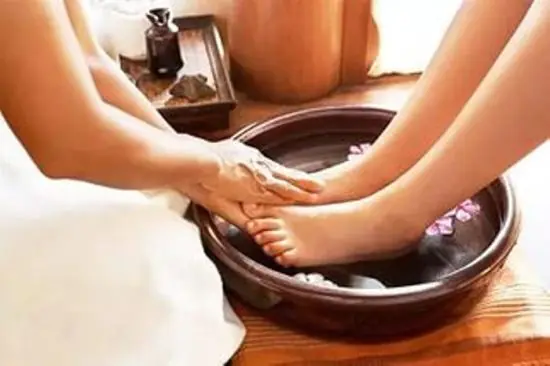
Foot baths. Baths with oils soften the skin of the feet well. To do this, you need to dilute 1 tbsp. l. flaxseed oil in a small bowl of warm water. The procedure takes about 10 minutes. Baths with natural decoctions calm and relieve inflammation. Chamomile and rose petals, taken in equal quantities and poured with boiling water, are perfect. Leave the broth for 20 minutes, then pour it into a container with warm water. After such procedures, you can give your child a light massage with cream.
Compresses with lemon. Lemon is known to have excellent softening properties. To do this, squeeze out a sufficient amount of juice and soak cloth napkins with it. Apply to problem areas (knees, elbows, heels) for 10 minutes. Lemon will dissolve the upper stratum corneum, which can be easily removed after the procedure with a damp towel.
Cucumber tincture. Cucumber copes well with dryness, moisturizes and refreshes. To prepare the tincture, pour vodka over freshly chopped cucumbers and leave for two weeks. The container with the mixture should be in the sun. Rub the cleansed skin of the feet with a towel soaked in the tincture. Can also be used on other dry areas. The skin will become soft and elastic.
Before using traditional medicine, it is preferable to conduct a sensitivity test on the child. Natural ingredients can become an unexpected source of allergies.
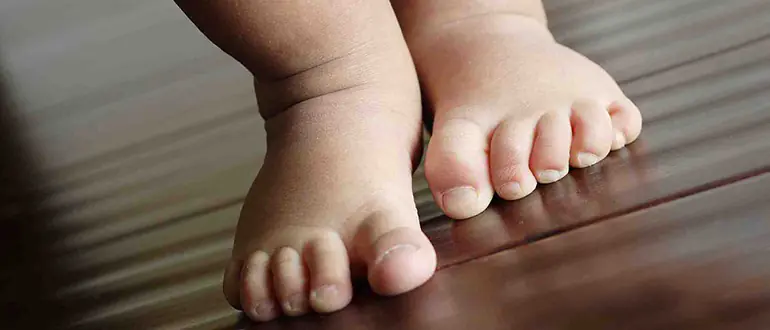
Dry skin on a child’s legs is a common problem caused by both improper care of the baby and a number of diseases that require competent professional treatment. If a child’s skin is peeling and dry, the triggering factors should be identified and the necessary measures taken to solve this problem.
Causes of dry and rough skin
The skin of a baby is distinguished by tenderness, thinness and increased sensitivity. Pediatricians identify the following causes of skin problems in children under three years of age:
- Incorrect, unbalanced diet. A lack of vitamins and microelements in a child’s body affects the condition of his skin, making it pale, dry, rough and flaky.
- Violation of the drinking regime. If a baby drinks less than 1.5 liters of water during the day, this leads to dehydration and dry skin.
- Unsuitable cosmetics (baby cream, soap and other hygiene products). It is important to select high-quality cosmetics that include only natural ingredients and are appropriate for the child’s age.
- Allergic reactions.
- Hormonal disorders.
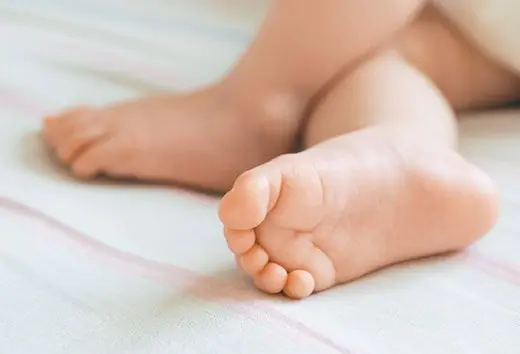
In some situations, dry skin becomes due to frequent bathing, dry indoor air and other external factors.
However, sometimes a similar phenomenon in children can act as one of the symptoms of diseases that require competent and timely treatment:
- Atopic dermatitis is a hereditary allergic disease. With this pathology, the child’s skin (not only on the legs, but also on the face and other parts of the body) becomes dense, rough, and covered with crusts.
- Eczema - accompanied by dryness, itching and burning sensation in the affected areas.
- Dermatitis - with this disease, individual dry spots appear on the child’s skin, having a predominantly round shape.
- Renal pathologies - manifested by disturbances in the process of urination, painful sensations localized in the lumbar region, permanent lack of appetite, and general weakness. The skin becomes not only dry, but also acquires a painful yellowish tint.
- Ichthyosis - with this disease, the skin becomes covered with blisters and specific scales.
- Hypothyroidism is a disease caused by disturbances in the functioning of the thyroid gland, accompanied by swelling, dry hair and skin, brittle nail plates, general weakness and increased fatigue.
If a child has such symptoms, especially if they persist for a long time, despite proper care for the baby, it is important to seek help from a doctor as soon as possible.
The problem is often associated with the physiological characteristics of the structure of the outer covering of infants. The fact is that the baby has difficulties with heat transfer, which is associated with insufficient development of the sweat glands.
The epidermis of an infant contains an increased amount of lipids, which, on the one hand, protect his skin from external influences, but on the other, can lead to dryness and irritation.

The following factors can provoke the appearance of dry and rough skin in a newborn:
- general overheating of the body;
- prolonged exposure to the sun;
- the use of air conditioners and heaters that dry out the air in the room;
- violation of hygiene standards.
To avoid troubles such as dry skin, you need to properly care for your child and humidify the air during the heating season, using special devices for this purpose or placing containers of water around the apartment.
Why does an allergy affect the skin?
In most cases, a child’s rough skin, prone to dryness, is a sign of allergic manifestations. Why is this happening? The fact is that allergies, in essence, are the body’s defense against foreign proteins.
Specific allergen substances can also provoke its manifestation. In a small child, the immune and enzymatic systems are not yet sufficiently developed, so even many food products are perceived by the body as provoking allergens. Foreign substances are removed from the child’s body through the skin and urinary system, which is why they suffer the most.
Most often, children are susceptible to a disease such as atopic dermatitis. In newborn babies, with proper therapy, it is possible to quickly eliminate the symptoms of the pathology and stop the further development of the disease.
In children over the age of one year, the disease is severe, often accompanied by the appearance of ulcers and damage to the deep layers of the skin. Treatment is difficult, and often the disease becomes chronic. However, the lack of therapeutic measures is fraught with the development of dangerous consequences: rhinitis, bronchial asthma, eczema, etc.
Which doctor should I contact?
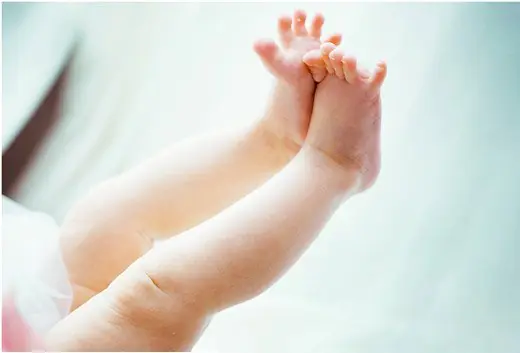
If your child has dry and rough skin on his legs, and even more so if there are other alarming symptoms, you should see a pediatrician.
The doctor will conduct an examination, study the clinical picture, analyze the collected medical history, and write out directions for tests. If necessary, the local pediatrician will refer you to such highly specialized specialists as a pediatric dermatologist, allergist, and endocrinologist.
Treatment
Therapy for dry skin of the feet in a child is prescribed individually, depending on the root causes that provoked this phenomenon and the age category of the little patient.
If dry skin is a symptom of a certain diagnosed pathology, then first of all it is necessary to treat the underlying disease. The course of health measures is developed by the doctor depending on the diagnosis, the age of the child, the stage and degree of the pathological process, and other features of a specific clinical case.
If the problem is caused by allergic reactions, poor nutrition or skin care for the baby, then it is enough to adjust your lifestyle to achieve positive results.
Medications are prescribed for diseases such as dermatitis, diabetes mellitus, hypothyroidism, renal and endocrine pathologies. Systemic medications are selected by a doctor according to an individual scheme. If dry, rough spots appear on the baby’s skin, the use of external medications (Fenistil ointment, etc.) may be recommended.
In the case of atopic dermatitis or severe allergic manifestations, the child is prescribed ointments and creams that contain hormones - glucocorticosteroids. Such drugs provide a good therapeutic effect, but they should be used only as prescribed by a doctor, strictly observing the dosage.

Hormonal drugs are discontinued gradually, reducing the amount of the drug over several days. In particularly complex, advanced cases, the use of antihistamines, calcium, and glucocorticosteroids may be recommended.
Diet therapy is the main method of treating and preventing dry skin in children. If the baby is breastfed, then the mother should exclude from the menu all foods that cause allergies.
If the problem arose after the introduction of complementary foods, it is recommended to restore the child’s usual diet for two weeks, and then reintroduce complementary foods.
Any product is included in the menu in a minimum quantity for three weeks. Such a scheme helps doctors identify the presence of a certain food allergen in a child that negatively affects the skin.
The basis of the baby’s diet should be the following foods:
- cucumbers, tomatoes;
- melon, pumpkin;
- spinach, carrots, cabbage;
- dairy and fermented milk products;
- eggs;
- porridge.
It is recommended to temporarily exclude sweets, fried foods, and citrus fruits from the menu of a small patient.

Traditional medicine helps a child with dry skin. The simplest and most effective recipes are:
- Foot baths. Dissolve a tablespoon of vegetable oil in a bowl of warm water. The optimal duration of the procedure is about 10 minutes. Excellent results are obtained by foot baths with decoctions, infusions of rose petals, sage, and chamomile.
- Cucumber infusion – has moisturizing, regenerating, refreshing properties. To prepare the medicine, you need to finely chop several fresh cucumbers, immerse them in a liter jar and fill them with alcohol or vodka. Place to infuse in a dark, cool place for two weeks. After the specified period, cucumber tincture can be used to treat the baby’s feet 1-2 times a day.
- Lemon compress - softens the skin, gives it softness and elasticity. To make such a remedy, just apply a little lemon juice to a gauze cloth and apply it to the affected area of the child’s skin, securing it with a plaster or bandage. Recommended exposure time is 10 minutes.
In case of serious illnesses, folk recipes can only be used as an addition to the main treatment after consultation with a doctor, especially if we are talking about very young children.
Consequences
If timely measures are not taken, dry skin on a child’s feet can lead to the following complications:
- the appearance of painful cracks;
- ulcerative, erosive lesions of the skin;
- eczema;
- chronic form of atopic dermatitis.
If the cause of dry and rough skin lies in the last of the listed points, then the development of chronic allergic reactions, bronchial asthma, and neuropsychiatric disorders is possible.
Prevention

It is easier to prevent any problem than to treat it. To avoid dry and rough skin on a child’s feet, doctors advise parents to pay attention to the following preventive recommendations:
- Take care of the child’s proper, balanced nutrition, provide his body with the necessary amount of vitamins A, B and E.
- Give your child as much fluid as possible, especially during hot periods, giving preference to clean water, milk, natural juices, and fruit drinks.
- Use natural children's cosmetics and avoid regular soap.
- Choose high-quality shoes made of genuine leather for your child that match his size.
- Avoid using socks, tights, and rompers made from synthetic materials.
Dry skin on a child’s feet is not the most serious problem, but this symptom causes the baby some discomfort and may also indicate the development of serious allergic diseases. Therefore, you should not ignore such a manifestation. Provide your baby with proper care, and if this does not help, first consult a pediatrician.

The moisture content of the skin of babies varies. Even a healthy baby may have a tendency to dry skin. This article will help parents understand what is normal and pathological.
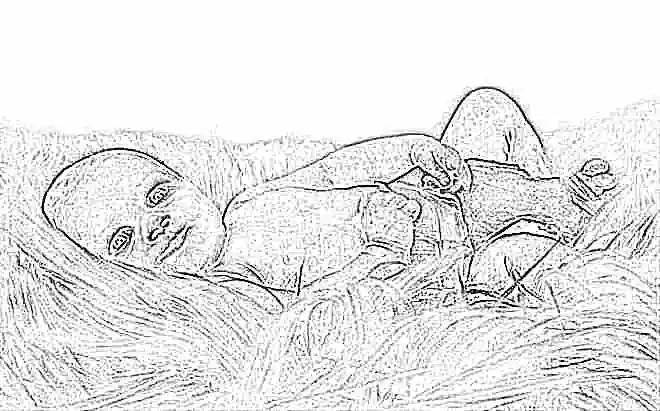
How does it manifest?
Dry skin is noticeably different in density from moisturized skin. This difference is usually identified by parents when cleaning their baby every day. In some cases, the skin becomes rougher and uneven to the touch.
Severe dryness can lead to the appearance of small cracks on the skin, which become possible “gates” for secondary infection.
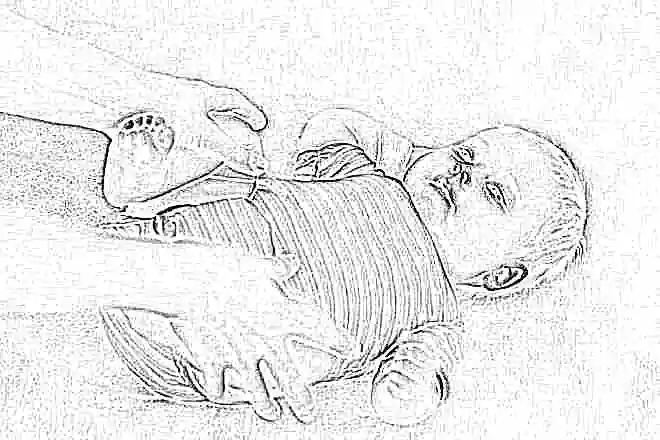
The color of dry areas of skin is noticeably different from healthy ones. They usually look lighter, and the skin texture may be disrupted.
The density of the affected areas decreases. The skin becomes less smooth and shiny. In some forms of allergic eczema, it looks “aged.”
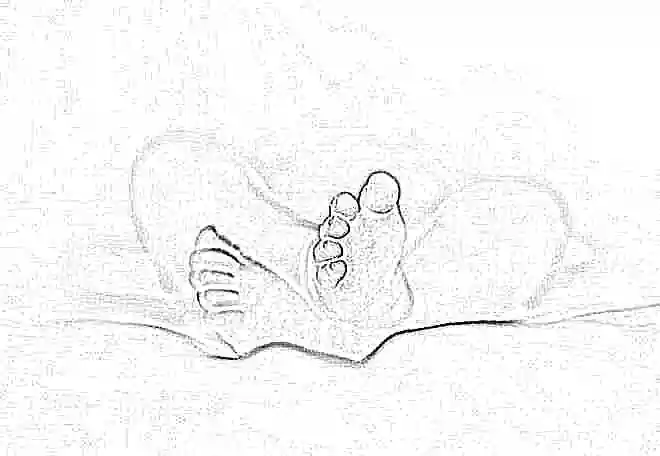
The localization of the appearance of dry areas largely depends on the initial cause that contributed to their development. If severe dryness appears between the toes, this often indicates that the child is developing scabies.
Dry fingertips are often a symptom of a vitamin deficiency or allergy. After suffering viral or bacterial infections, in some cases, dry skin may also increase.
If, for some unknown reason, a child’s palms become dry and the skin itching intensifies, then you should pay attention to what soap he uses to wash his hands.
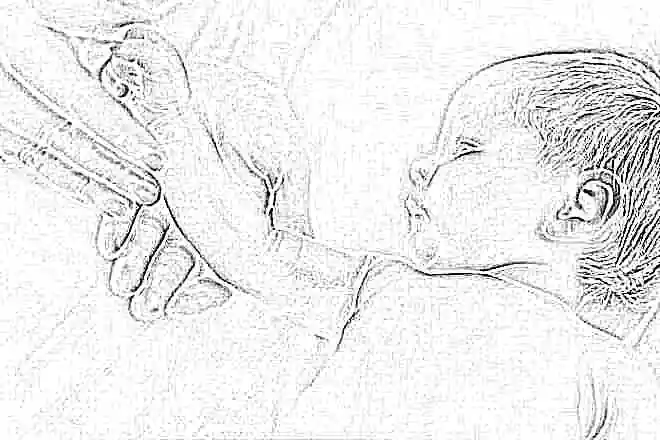
Causes
According to statistics, dry skin of the hands and feet most often occurs in newborn babies and children in the first year of life.
Many parents prefer to cope with this condition at home, without seeking medical help. Others believe that it is impossible to cope with increased dryness on their own.
In order to understand in which case you may need to consult a specialist, you should first understand what doctors consider healthy skin.
The baby's skin is usually smooth to the touch. Optimal skin hydration is ensured by complex metabolic processes. The condition of the skin largely depends on how well the child’s water-lipid layer is expressed. A special ratio of hydrophilic molecules and lipid fractions ensure proper hydration of the skin layers.
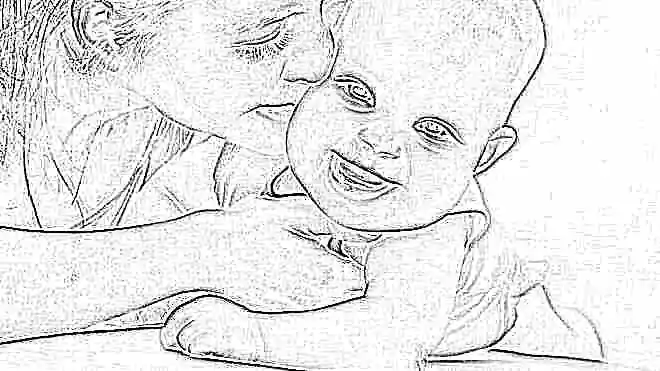
A variety of reasons lead to the development of excessive dryness in a baby. The delicate skin of a child is very sensitive to the effects of numerous environmental factors. Such unfavorable causative factors include:
Hypothermia or overheating of the skin leads to disruption of the water-lipid layer, which is manifested in the child by the development of severe dryness.
Walking and playing outside in windy weather without gloves and mittens leads to various dry areas appearing on the baby's fingers. Quite often they peel a lot.
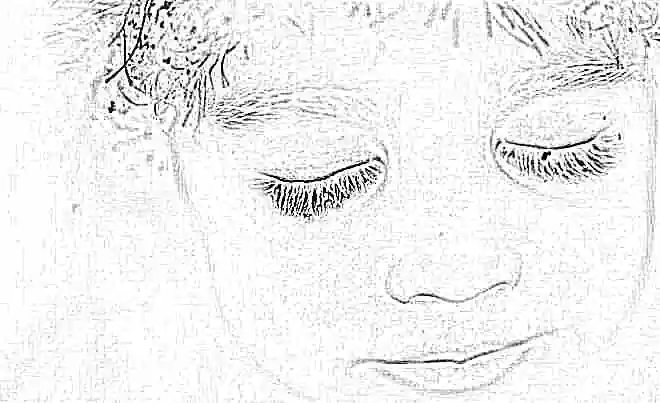
Normally, the humidity in the room should be between 50 and 60%. Too dry air causes the child to develop quite dry areas on the skin, which in some cases may be a little itchy.
Scratching the skin can contribute to the introduction of a secondary bacterial infection, which becomes the cause of infectious skin diseases in the future.
Quite often this situation occurs with infants. Keeping a baby in hot water disrupts the water-lipid layer of the skin, resulting in dryness on the baby's legs.
This symptom also often appears on the toes.

An underactive thyroid gland or hypothyroidism is quite common in children. One of the clinical signs of this condition is the appearance of dry patches on the skin.
Irritable bowel syndrome and dysbiosis also lead to disruption of metabolic processes that occur in the skin.
Insufficient content of microelements in children's daily diet contributes to metabolic disorders. Quite often, a deficiency of vitamins A, E and B causes a child to develop severe dry skin.
In infants, the appearance of dry spots on the skin is caused by incorrectly selected adapted artificial formula for feeding.
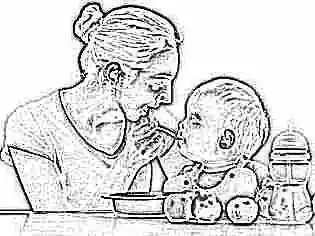
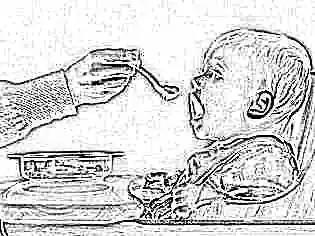
Allergies, especially during periods of exacerbation, many types of dermatitis and eczema occur with the appearance of severe dryness of the skin. In some pathologies, the affected areas are quite large in area.
Often allergic skin manifestations are accompanied by severe itching, which brings severe discomfort to the child and worsens his well-being.
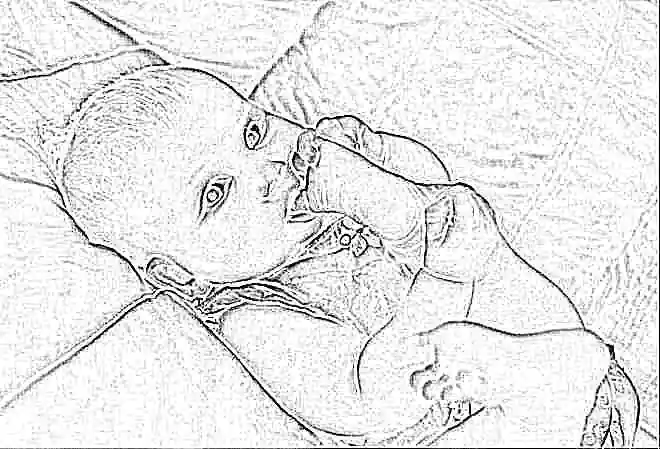
During their life, helminths (worms) secrete a large number of various biologically active substances that have a toxic effect on the skin.
Persistent helminthiasis is usually accompanied by the development of severe dry skin in the child and the appearance of various skin rashes on it.
Quite common in adolescence and puberty. A surge of systemic hormones has multiple effects, including on the skin.
Usually this situation contributes to changes in the structure of the skin. It tends to become drier and more prone to developing rashes.
Quite often, the development of dry skin in children is caused by excessive use of body lotions containing alcohol or active chemical components.
Long-term use of these products causes the delicate children's skin to become very dry and various rashes appear on it more often.
Using tar or laundry soap to wash young children can also cause severe dryness in the child.
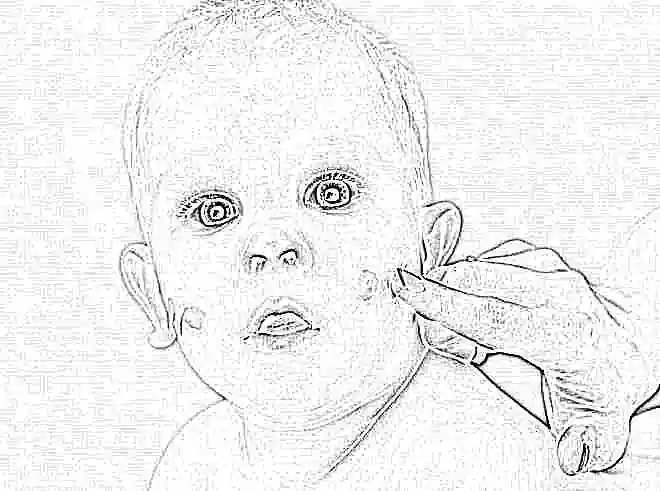
To replenish the loss of fluid that is physiologically excreted from the body through sweat, urine, saliva and feces, a mandatory replenishment of water is required.
A decrease in the volume of fluid consumed per day contributes to the fact that the baby develops pronounced disturbances in skin moisture and turgor.
This is especially noticeable during hot weather and after active sports.
Scabies
This disease, caused by the scabies mite, is quite often recorded in children. Children attending educational institutions are at increased risk.
Doctors note that scabies is most common in crowded groups. The disease usually manifests itself as dry patches of skin between the fingers, which are very flaky.

Diagnostics
A pediatric dermatologist will help distinguish pathology from the norm. A visit to this specialist is necessary.
In some cases, dangerous diseases are hidden behind the mask of increased skin dryness, which are then detected only in the later stages. Timely seeking advice from a doctor will help avoid negative consequences and prevent the development of unfavorable pathologies.
Initially, the cause that led to the development of dryness in the child should be established. If it is not eliminated, subsequent symptomatic treatment will have only a temporary unstable result.
In some cases, establishing the cause of this condition requires a whole range of diagnostic measures. The baby undergoes general clinical blood and urine tests, biochemical tests, as well as an ultrasound of internal organs. Such an expanded diagnosis makes it possible to clarify the cause that caused the child to develop unfavorable symptoms.
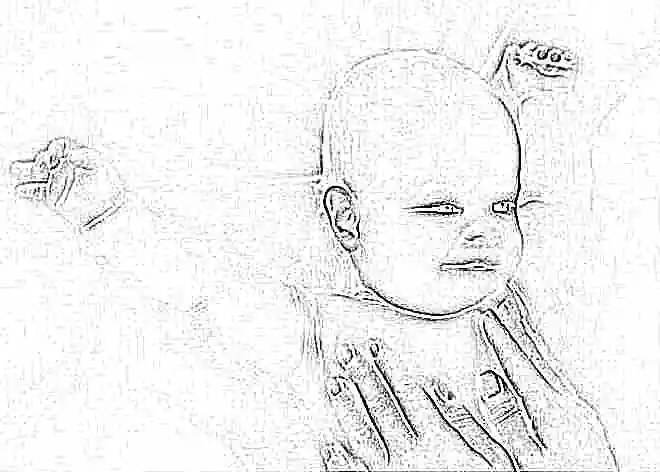
Treatment
After conducting a complex of diagnostics, doctors make recommendations. Typically they include adherence to the following principles:
Your baby's daily diet must contain healthy unsaturated fats. Including dishes made from red fish and containing vegetable oils in the children's menu will have an excellent effect on the skin.
To compensate for vitamin deficiencies, you should definitely include a wide variety of fruits and vegetables in your baby’s diet.
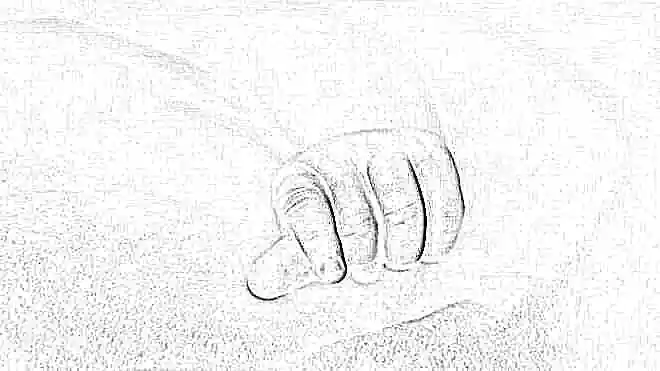
Currently, there is a huge variety of cosmetic products. Their regular use helps improve the water-lipid layer of the skin and improve its appearance.
For cosmetics, you should use products that are approved and specifically designed for children.
They should not contain any aggressive chemical components that contribute to allergic reactions on the skin or increase dryness.
Do not overdry the skin during hygiene procedures. Very often this happens while bathing a child.
The duration of water procedures is strictly regulated taking into account the age of the baby. Sitting in hot water for more than the prescribed period contributes to dryness and subsequently irritation of the skin.
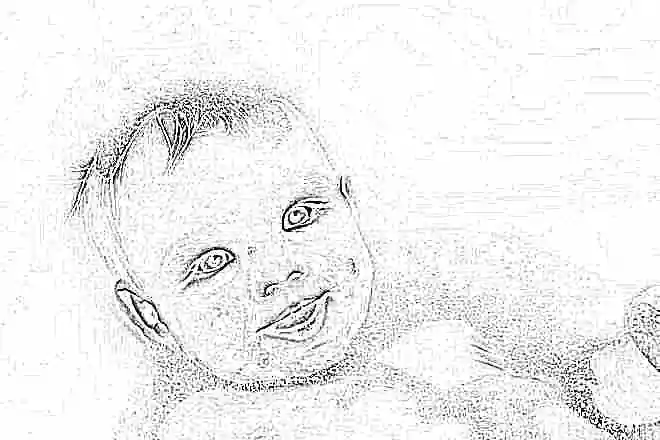
If your baby is prone to skin irritation, you can add decoctions made from medicinal herbs to the baths. Chamomile, calendula, and sage are perfect for this.
The use of these products is also an excellent prevention of infectious secondary skin rashes.
You will learn about skin care for newborns in the following video.



